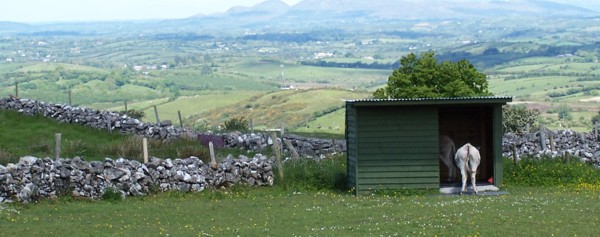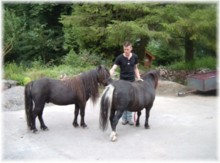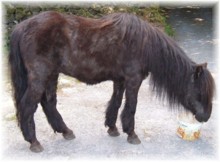Newsletter Autumn 2006
In mid-October we were delighted to welcome Peter Hanssen and Else Kingmar to fill our long researched post of live-in Sanctuary managers. Peter learned of our interest through a farrier friend who works on a voluntary basis for a Dutch donkey sanctuary and visited immediately to see if we shared similar philosophies on animal welfare and husbandry, returning for a second visit with Else to work with us a few weeks before making the final decision to join us here. As young people they are not in a position to fund themselves entirely so our challenge now is to raise a workable salary for them on an ongoing basis. Obviously we’ll be delighted to hear from anyone with good fundraising ideas!

TRIBUTE TO WALLACE
Our “Wallace” field shelter for the older donkeys is now complete thanks to the building skills of German Sammie, Dutch Peter and multi-national Joost ~ a true combined effort funded through the generosity of Dr. Bill Arnould-Taylor and Kim and John Aldridge of England. It is a comfortable timber built structure blending into the surrounding environment and has rubber mat flooring for ease of maintenance and comfort. An exterior noticeboard tells visitors the story of Wallace and a little information about the “golden oldies” who are currently in residence.

Jennie inspecting the new quarters
WELFARE CALLS - WATER
As usual we have been busy with a seemingly endless stream of welfare calls but are encouraged as almost all have been resolved on site. Many were again to do with inadequate water supplies during the hot, dry weather as people used to natural water supplies failed to check if they were still running. It is true that donkeys CAN survive a few days without water but this is not say that it would be their choice, and certainly the old saying that donkeys only drink on Palm Sunday is nonsense.
FLIES
A greater volume of flies in the warm weather also created problems for many animals. Apart from the obvious torment of having them endlessly buzzing around their faces, flies bite and drink from the pockets of moisture around an animal’s eyes and other orifices which often result in sore, infected areas which in turn attract more flies. Use of a fly mask, fly fringes, fly rugs, fly repellants and pour-ons are all helpful in keeping this problem under control though the simplest and most effective method is to provide a dark, dry shed into which the animals can hide, at will, from both adverse weather conditions and flies.
AND TETHERING PROBLEMS (AGAIN!)
We also received another spate of calls about badly tethered animals, including one little guy who had to be euthanased as a result of too tight fettering by the leg. The blood supply had been completely cut off for some hours, the leg became necrotic, gangrene set in and a beautiful young animal lost it’s life through sheer carelessness.
GOODBYE TO JENNIE
Sadly just as we were writing this newsletter we had to say goodbye to dear Jennie, affectionately known as both “the wonky donkey” because of her broken jaw which left her mouth damaged so her tongue fell out, and “the bulldozer” for her ill-mannered habit of walking through everyone and everything instead of around! Her foghorn bray was always the first to welcome each day and despite the times I hid under the bedcovers trying not to hear her at 6am, she will be very much missed. Jen came to us from Coopers Hill, Riverstown, where she was born and spent her life before retirement here. She was 35 years old and suffered heart and renal failure.

CRAZY ABOUT CREATURES SPONSORED WALK
This year we have to say a special thanks to all who supported and walked on the day raising in excess of €4,000 shared between ourselves and the Sligo Society for the Prevention of Cruelty to Animals. The reason? It absolutely lashed with rain all day so even those of us who were kitted out in full waterproof gear were through to the skin by the half way mark. We applaud the back-up team who provided much needed and appreciated nourishment at the top of the Ox Mountains, where, unfortunately, the amazing view was obscured by mist and rain. Thanks to everyone!! We hope for better weather next year.
NEDDY’S PAPLOMA
In September Neddy Flat Tyres had to have a 2” (5cms) long paploma removed from between his teeth. The paploma, which is a virally induced, benign but fast growing growth was removed by local anaesthetic as it interfered with his eating and was obviously causing distress. The operation was successful and Ned is back to all his old tricks - with a smile!
TEETHING PROBLEMS
Bobbie and Cobweb, two small ponies who were enjoying the good life in a foster home were returned to us when Bobbie started to lose weight dramatically and their foster-carer found herself unable to cope with the extra workload and anxiety of constantly feeding one pony whilst dieting the other. No easy task, especially as Cob is the greediest pony imaginable. We suspected tooth trouble as Bobbie is a great age - around 35 years old - and was unable to masticate his food.

On arrival

A few weeks later
Equine dentist Lisa Molloy attended with vet Evi Stabler and sure enough Bobbie had to have five teeth extracted. At some stage in his life Bobbie had lost some of the opposite teeth, so without a wearing surface on which to grind down, the remaining teeth had contined to grow until they locked into the opposite gums, preventing mastication and causing considerable pain.
The size of teeth (2” or 5cms long) confirms the problems that these small ponies have when they are bred down in size but retain the full sized teeth of a large horse. With the present fashion for breeding all things in miniature other problems can also arise like tiny ponies and donkeys with normal sized bodies supported on abnormally short legs.
Click here to see Bobbie’s five teeth with a 20c coin for scale
AND MORE ON BREEDING
The subject of breeding returns us once more to our regular visits to horse fairs and marts. Unfortunately we see an increasing number of both donkeys and small ponies, many of them imported. The majority of the young donkeys for sale are males as with the fashion for breeding, only the females are wanted and therefore considered valuable. If you are considering buying a donkey please bear in mind that a donkey mare can only produce one foal every 11 to 14 months and has a 50% chance of producing a male. Consequently the logic that “there is money in breeding donkeys” doesn’t really hold up!
THANKS ALL ROUND
Of the many people to thank this time we are most grateful to Sue and Colin who homed Paddy, alias Tattletale, a beautiful 20 year old pony who could no longer be ridden due to tendon damage; to Eli and Hartmut Krinitz who raised the amazing sum of €1,901.94 during their tourist film shows in Germany and Switzerland;to Seamus and Ethel Reynolds for 5 round bales of dry mixed bedding; to the Latchford family for of hay and barley straw, to Emily Murphy for faithfully producing, as needed, more 12 minute DVD’s about the Sanctuary’s work and helping with the website; to Kieran Stafford for acquiring our new website host name of www. donkeys.ie and for agreeing to set up and help manage our new website; to Innishfree Veterinary Clinic for including us in a bequest disbursement of €400, to Michelle and Sean McFarlane for €315 raised on an 18 mile sponsored walk; to Kiane Keevans for raising €239 with an essay competition for National School children in the Ballymote area,and many more. Thank you all for you hard work and generosity.
MISSING, PRESUMED........ IN UK?
Our introductory Sanctuary sign at the end of the road was last seen being placed in the boot of a green English registered car before the driver left in haste towards the N4. If anyone can tell us where it might be now, we’d love to hear from them. These signs cost money we would pefer to spend on welfare!
POSTSCRIPT - TETHERING YET AGAIN!
We were recently called to a valuable horse filly who slipped and permanently damaged her hock when left unattended on a long line. A passing vehicle frightened her and within seconds she had her feet tangled in the rope with disastrous results. These “accidents” are usually unintentional but can be avoided with commonsense. The motto is please NEVER tether an animal unless absolutely necessary, NEVER leave it unattended and CHECK at very regular intervals.
YOUTH ACTION PROJECT
Of our many visitors we particularly welcomed Marie with 12 youngsters on the Youth Action Programme in Sligo (YAPS). The boys were all from underprivileged backgrounds and from troublesome housing estates where the incident of animal cruelty was excessive. Marie and her team routinely involved the boys in a scheme through which they themselves took responsibility to approach animal welfare in a positive way with the specific intent to influence their peers and contemporaries accordingly. This included an afternoon at the Sai Sanctuary where the boys learned about handling and husbandry methods for the donkeys and ponies (burning off some energy re-stacking straw bales), two visits to a dog trainer who taught them how to handle and train dogs through quiet, humane methods and a “Wow factor” visit to a local raptor centre where they learned that even birds will respond positively to human kindness. The result at the end of the summer was a 100% drop in animal cruelty in the area where the boys lived, suggesting that not only had they learned significant lessons from the experiences themselves but had, indeed, successfully influenced their friends, siblings and maybe even their parents. A film was made to document the boys’ progress and to help promote the idea in other troublespots throughout the country.
PRE-SCHOOL GROUP VISIT
Younger groups included two visits from Little Buddies pre-schoolers who enjoyed truly beautiful weather on both occasions so the children were able to integrate with the older, gentle donkeys.
Although the amount of factual knowledge that can be passed on to this age group is limited we firmly believe the first impressions gained through interaction eg. the loss of initial fears or hesitancy and the responsiveness of the donkeys to quiet handling as opposed to rough noisy handling, have an important impact on these children that sets a precedence for future behaviour around animals. We are grateful to the carers who took the time and trouble to organise the outings and patiently encouraged the children to enjoy the benefits of the day.